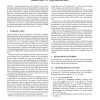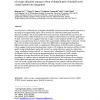109 search results - page 1 / 22 » When Are Behaviour Networks Well-Behaved |
ECAI
2004
Springer
13 years 10 months ago
2004
Springer
Agents operating in the real world have to deal with a constantly changing and only partially predictable environment and are nevertheless expected to choose reasonable actions qui...
PR
2011
12 years 7 months ago
2011
This paper aims to address the problem of anomaly detection and discrimination in complex behaviours, where anomalies are subtle and difficult to detect owing to the complex tempo...
Publication
This paper aims to address the problem of anomaly detection and discrimination in complex behaviours, where anomalies are subtle and difficult to detect owing to the complex tempor...
AROBOTS
2010
13 years 5 months ago
2010
Locusts possess a bilateral pair of uniquely identifiable visual neurons that respond vigorously to the image of an approaching object. These neurons are called the lobula giant m...
AINA
2009
IEEE
13 years 11 months ago
2009
IEEE
When designing a complex system such as a sensornet it is not always practical to build and deploy a realistically sized prototype. At the same time many of the interesting behavi...



